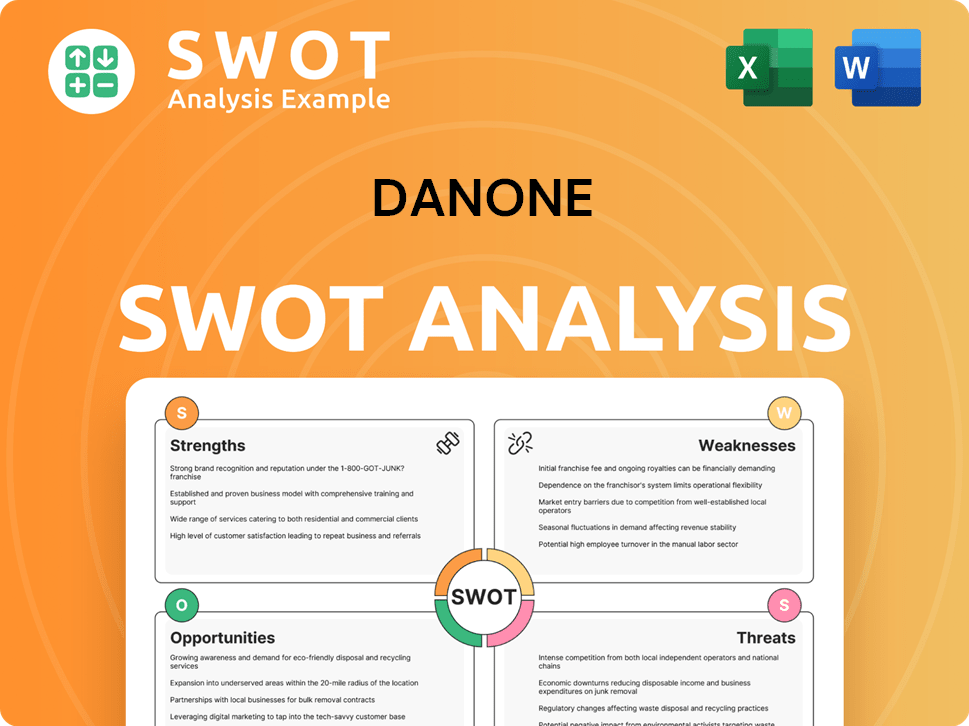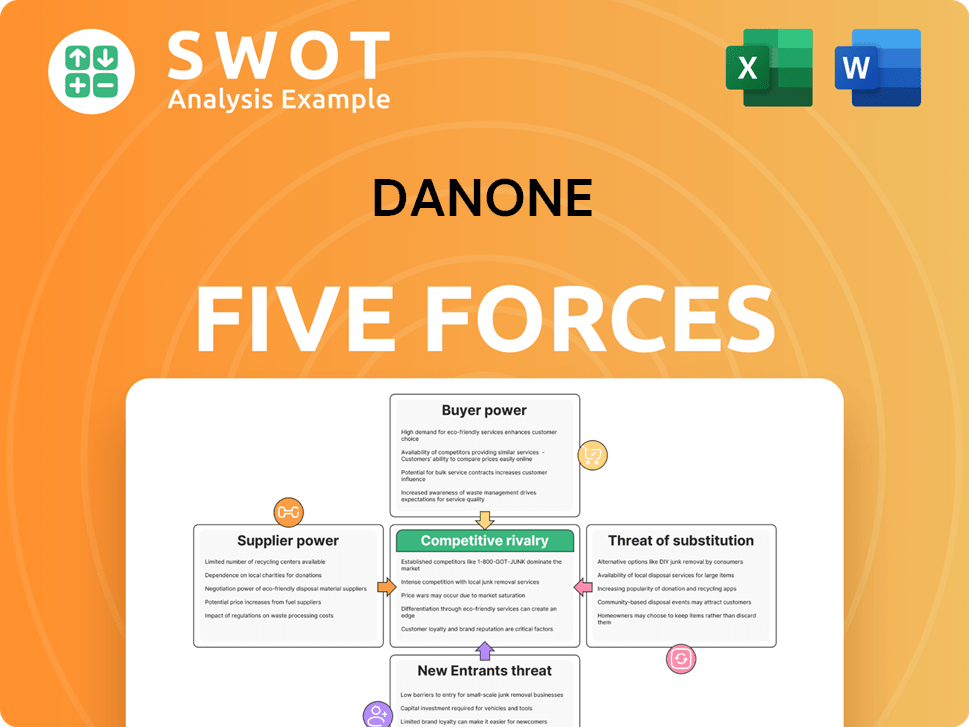Danone Bundle
How Does Danone Dominate the Global Food and Beverage Market?
Danone, a titan in the food and beverage industry, consistently adapts its Danone SWOT Analysis to stay ahead. Its 'Renew Danone' initiative, launched in 2022 and continuing into 2025, underscores a commitment to sustainable growth by connecting human health with planetary well-being. This strategic shift is crucial for understanding the company's current trajectory.

This exploration of Danone's sales and marketing strategy will dissect its innovative approach to reaching consumers, from its distribution strategy to its digital marketing strategy. We'll analyze its brand positioning strategy, examining how Danone leverages its core values to resonate with its target audience. By examining its marketing campaign examples and sales performance analysis, this article provides actionable insights into the strategies that have propelled Danone to global leadership, including its international marketing strategy and customer relationship management strategy.
How Does Danone Reach Its Customers?
The sales channels employed by the company, a global food and beverage leader, are diverse and designed to reach consumers worldwide. Its approach includes both traditional and modern methods, ensuring broad market coverage. This multi-channel strategy supports its overall Danone sales strategy, which is crucial for maintaining and growing its market presence.
A key component of the company's distribution network is its extensive use of traditional retail outlets. These include supermarkets, hypermarkets, convenience stores, pharmacies, and health-focused retailers. This widespread presence is complemented by a strong focus on e-commerce and 'away-from-home' channels, which is part of the Danone marketing strategy.
The company's strategic focus involves expanding its reach through various channels, including mass retail, 'away-from-home' channels, and e-commerce platforms. This approach is vital for adapting to changing consumer behaviors and maintaining a competitive edge in the market. The company's Danone strategy is designed to enhance its market position and ensure its products are accessible to consumers globally.
Mass retail channels, such as supermarkets and hypermarkets, remain a significant part of the company's distribution strategy. In 2024, approximately 49% of the company's Essential Dairy and Plant-Based (EDP) business sales were generated through mass retail. This channel continues to be a cornerstone of its sales efforts, ensuring broad consumer access to its products.
The company has strategically expanded its presence in 'away-from-home' channels. These include hospitals, pharmacies, and home care services. These channels collectively accounted for over 50% of its sales in 2024. They are growing at a rate two to three times faster than mass retail, highlighting their importance.
E-commerce is a key focus, with collaborations with major platforms like Amazon and Walmart. The company is investing in direct-to-consumer (D2C) channels, offering subscription services. The company's organic baby food brand, Happy Family Organics, has been a pioneer in e-commerce, prioritizing resources and investment in this channel.
The company is investing in direct-to-consumer (D2C) channels, offering personalized subscription services for specific product lines such as baby food and medical nutrition. This approach allows for enhanced customer engagement and tailored product offerings, improving customer loyalty and sales. The company is leveraging cloud-based commerce platforms to develop new e-commerce solutions globally.
The company's sales strategy is built on a multi-channel approach, focusing on both traditional and modern sales methods. This includes leveraging mass retail, expanding 'away-from-home' channels, and investing heavily in e-commerce. This strategy is designed to meet changing consumer demands and market dynamics.
- Strategic expansion into 'away-from-home' channels, including hospitals and pharmacies, which are growing rapidly.
- Prioritizing e-commerce through major platforms and D2C channels, with dedicated teams and cloud-based solutions.
- Utilizing data analysis to enhance product offerings and adapt to specific market needs.
- Focusing on personalized subscription services for specific product lines.
- Collaborating with major e-commerce platforms like Amazon and Walmart.
Danone SWOT Analysis
- Complete SWOT Breakdown
- Fully Customizable
- Editable in Excel & Word
- Professional Formatting
- Investor-Ready Format

What Marketing Tactics Does Danone Use?
The company employs a multifaceted marketing approach, integrating digital and traditional tactics to enhance brand visibility and drive sales. This strategy emphasizes health and wellness, resonating with consumer preferences. The aim is to build strong customer relationships and increase market share. The Competitors Landscape of Danone reveals the dynamic nature of the industry, influencing the company's strategic decisions.
Digital platforms, content marketing, and paid advertising are key elements of the company's marketing strategy. The company utilizes advanced analytics and AI to enhance marketing effectiveness. Influencer partnerships and experiential marketing also play crucial roles in engaging consumers. These tactics support the overall Danone sales strategy and Danone marketing strategy.
The company's marketing efforts are data-driven and customer-focused, reflecting a commitment to adapting to evolving consumer behaviors. This approach allows for targeted and effective campaigns, ultimately supporting its strategic goals. The Danone strategy is designed to maintain a competitive edge in the market.
The company actively uses social media platforms like Facebook (with approximately 1.3 million followers), Instagram, LinkedIn (with about 2.6 million followers), and Twitter (with around 37.5k followers) to engage with consumers. Content marketing through blogs and articles on nutrition, healthy eating habits, and sustainability is also a key part of the strategy.
The company's website, danone.com, employs robust SEO strategies, attracting over 170,000 visitors per month through approximately 70,719 organic keywords. This helps improve online visibility and attract potential customers.
Paid advertising, including digital advertising, is a key component of the promotional strategy. The company is implementing Gen AI-enabled initiatives for consumer segmentation in China and customer care in Europe, allowing for personalized ad versions and tailored consumer journeys.
Influencer partnerships play a significant role in amplifying brand messages and building credibility. In 2024, the company North America committed to using influencers primarily directed to children under 13 only for products meeting specific nutrition criteria.
Traditional media, such as television ads and events, continue to be utilized. Experiential marketing, like the Oikos SnackMobile campaign, which distributed free samples and created memorable interactions, also contributes to brand awareness and community engagement.
The company's marketing emphasizes health and wellness messaging. This focus aligns with consumer preferences for healthier products and lifestyles. This strategy is crucial for the Danone brand positioning.
The company utilizes a mix of digital and traditional marketing tactics to engage consumers. The Danone company focuses on digital marketing, content marketing, and influencer partnerships to build brand awareness and drive sales. The company's Danone products are promoted through various channels.
- Social Media Engagement: Actively uses platforms like Facebook, Instagram, LinkedIn, and Twitter to connect with consumers.
- Content Marketing: Develops blogs and articles on nutrition, healthy eating, and sustainability to position itself as a trusted source.
- SEO and Website Optimization: Employs robust SEO strategies to attract visitors to its website.
- Paid Advertising: Utilizes digital advertising to promote products and reach target audiences.
- AI and Data Analytics: Implements Gen AI for consumer segmentation and personalized marketing.
- Influencer Partnerships: Collaborates with influencers to amplify brand messages and build credibility.
- Experiential Marketing: Engages consumers through events and campaigns like the Oikos SnackMobile.
- Traditional Media: Continues to use television ads and events to reach a wider audience.
Danone PESTLE Analysis
- Covers All 6 PESTLE Categories
- No Research Needed – Save Hours of Work
- Built by Experts, Trusted by Consultants
- Instant Download, Ready to Use
- 100% Editable, Fully Customizable

How Is Danone Positioned in the Market?
The brand positioning of the Danone company centers on health and sustainability, a strategy that distinguishes its Danone brand from competitors. This approach aligns with evolving consumer values, emphasizing a commitment to both human and environmental well-being. The core message, encapsulated in its mission, is to 'bring health through food to as many people as possible,' guided by the 'One Planet. One Health' vision.
This vision is pivotal in shaping the Danone sales strategy and Danone marketing strategy. It guides the company's efforts in providing science-backed nutritional products and promoting sustainable food production. The company's focus on health-conscious consumers and its expansion into plant-based alternatives demonstrate its responsiveness to market trends and consumer preferences. This focus is crucial for the Danone strategy.
The visual identity, tone of voice, and customer experience consistently reflect this health-focused and responsible approach. Danone products appeal to their target audience—middle and upper-middle-class urban families who prioritize well-being—by offering products that provide nutritional benefits and cater to health-conscious individuals. The company has strategically expanded its product range to include plant-based alternatives under brands like Alpro, Silk, and Vega, capitalizing on the growing demand for healthier and more sustainable food options driven by health consciousness and environmental concerns.
Sustainability is a core marketing pillar, enhancing the Danone brand reputation and appealing to eco-conscious consumers. The company has set ambitious goals, including achieving carbon neutrality by 2050. Danone aims for global B Corp certification by 2025, with Danone Egypt already achieving this in 2019.
Brand consistency is maintained across various channels and touchpoints, from product transparency and clean labeling to its engagement on social media platforms. Danone is committed to ensuring that 95% of dairy and plant-based products feature interpretive nutritional information by 2025. The company is also focused on its Growth Strategy of Danone.
Danone's agility in adapting to market trends, such as the rising demand for high-protein products and the impact of GLP-1 drugs, further solidifies its position as a leader in health and nutrition. This adaptability is crucial for maintaining and growing Danone's market share.
The Danone target audience analysis reveals a focus on middle and upper-middle-class urban families. These consumers prioritize well-being and are increasingly health-conscious. This focus drives product innovation and marketing efforts.
Danone's product launch strategy includes expanding its range to include plant-based alternatives. Brands like Alpro, Silk, and Vega cater to the growing demand for healthier and sustainable food options. This diversification supports Danone's overall sales and marketing plan.
Danone's digital marketing strategy includes a strong emphasis on social media. This approach allows the company to engage with consumers, build brand awareness, and promote its products effectively. Danone's social media strategy is key.
Danone's competitive analysis strategy focuses on differentiating itself through health and sustainability. This approach helps the company stand out in a crowded market. The company's Danone brand positioning strategy is well-defined.
The Danone pricing strategy and distribution strategy are designed to reach its target audience effectively. These strategies ensure that products are accessible and competitively priced. This supports the Danone's customer relationship management strategy.
Danone Business Model Canvas
- Complete 9-Block Business Model Canvas
- Effortlessly Communicate Your Business Strategy
- Investor-Ready BMC Format
- 100% Editable and Customizable
- Clear and Structured Layout

What Are Danone’s Most Notable Campaigns?
The Revenue Streams & Business Model of Danone has been shaped by several key sales and marketing campaigns. These initiatives have been instrumental in building the brand's reputation and driving growth. The focus has often been on health, wellness, and sustainability, reflecting consumer trends and the company's broader strategic goals.
One of the notable examples is the 'Oikos SnackMobile' campaign in Canada, which aimed to increase the visibility of the Oikos yogurt brand. This experiential marketing strategy involved a mobile canteen distributing free samples at events, generating thousands of consumer interactions. The goal was to boost brand recognition and enhance consumer loyalty through direct product experiences.
Another significant campaign includes the 'Activia Challenge,' which utilized influencer marketing to promote the benefits of Activia yogurt within a balanced diet. This strategy successfully engaged fitness influencers to share their personal experiences, encouraging participation and improving brand perception. Furthermore, in September 2024, the company launched Actimel+ Triple Action across 20 European countries, marking 30 years of Actimel. This new range, fortified with vitamins D, B6, C, and magnesium, underscores the company's commitment to immunity-boosting products, responding to research indicating that 62% of people prioritize a healthy immune system.
The 'Oikos SnackMobile' in Canada was a key initiative. It distributed over 480,000 free yogurt samples. This experiential campaign generated over 550,000 memorable consumer interactions.
The 'Activia Challenge' used influencer marketing. Fitness influencers shared their experiences, encouraging participation. This strategy improved brand perception and engagement.
The 'Light & Free' campaign targeted millennials. It used vibrant packaging and social media. The campaign aimed to promote body positivity and self-expression.
Nutricia focuses on the clinical benefits of products. It uses scientific research and expert testimonials. The strategy includes educational initiatives on health management.
The company is adapting its marketing strategies. This includes responding to the rise of GLP-1 drugs. Campaigns like the Super Bowl 59 initiative in 2024 targeted consumers. This multi-channel approach aims to guide consumers in their nutritional journey.
- Multi-channel approach for reaching consumers.
- Focus on nutritional guidance amidst changing health trends.
- Preparing for future product offerings.
Danone Porter's Five Forces Analysis
- Covers All 5 Competitive Forces in Detail
- Structured for Consultants, Students, and Founders
- 100% Editable in Microsoft Word & Excel
- Instant Digital Download – Use Immediately
- Compatible with Mac & PC – Fully Unlocked

Related Blogs
- What are Mission Vision & Core Values of Danone Company?
- What is Competitive Landscape of Danone Company?
- What is Growth Strategy and Future Prospects of Danone Company?
- How Does Danone Company Work?
- What is Brief History of Danone Company?
- Who Owns Danone Company?
- What is Customer Demographics and Target Market of Danone Company?
Disclaimer
All information, articles, and product details provided on this website are for general informational and educational purposes only. We do not claim any ownership over, nor do we intend to infringe upon, any trademarks, copyrights, logos, brand names, or other intellectual property mentioned or depicted on this site. Such intellectual property remains the property of its respective owners, and any references here are made solely for identification or informational purposes, without implying any affiliation, endorsement, or partnership.
We make no representations or warranties, express or implied, regarding the accuracy, completeness, or suitability of any content or products presented. Nothing on this website should be construed as legal, tax, investment, financial, medical, or other professional advice. In addition, no part of this site—including articles or product references—constitutes a solicitation, recommendation, endorsement, advertisement, or offer to buy or sell any securities, franchises, or other financial instruments, particularly in jurisdictions where such activity would be unlawful.
All content is of a general nature and may not address the specific circumstances of any individual or entity. It is not a substitute for professional advice or services. Any actions you take based on the information provided here are strictly at your own risk. You accept full responsibility for any decisions or outcomes arising from your use of this website and agree to release us from any liability in connection with your use of, or reliance upon, the content or products found herein.